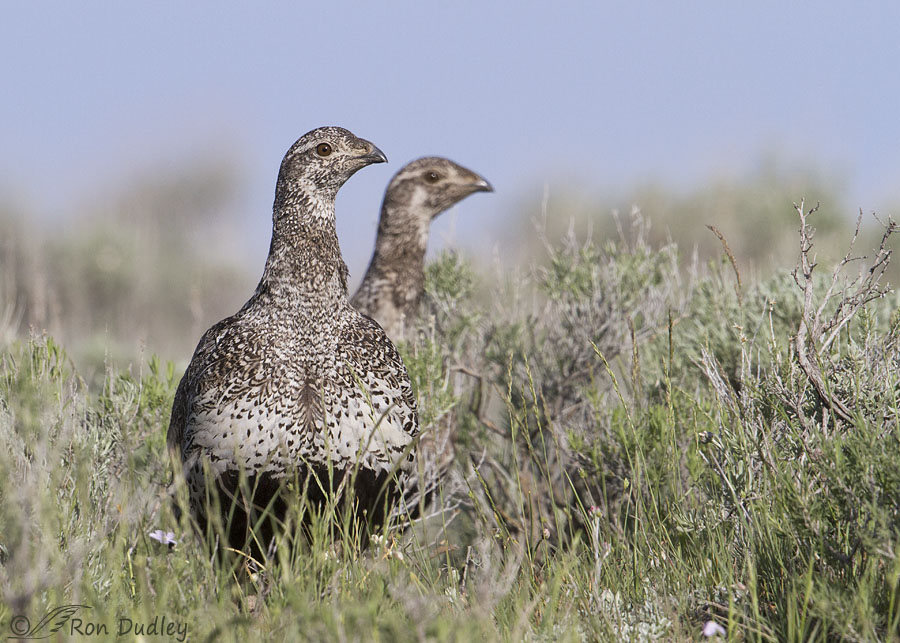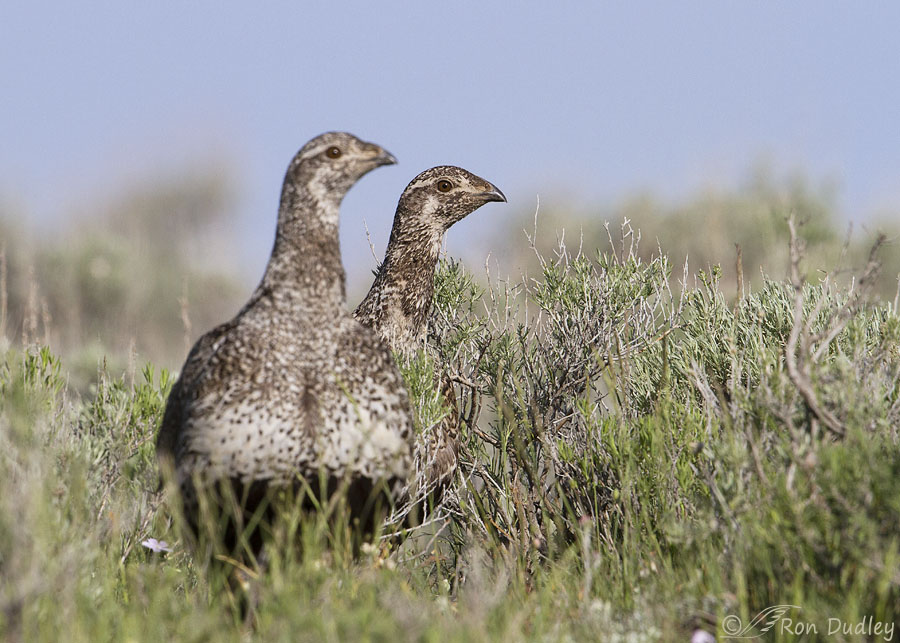In bird photography we often learn by trial and error and experimentation. This is one of my early photography “field investigations” using a pair of Greater Sage Grouse on Utah’s Aquarius Plateau.

1/1000, f/13, ISO 500, Canon 7D, Canon EF 500mm f/4L IS II USM + EF 1.4 III Extender, not baited, set up or called in
I’d already spent some time photographing individual Sage Grouse in the small flock among the sagebrush when these two poked their heads up one in front of the other. This situation is seldom ideal for the bird photographer because at these focal lengths (I was shooting at an effective 1120mm) my depth of field is very shallow so one or the other of the two birds is likely to be very soft, depending on which one I focus on. Usually (though not always) we would want both subjects to be sharp.
The general rule of thumb in these challenging situations is that it’s best to have the foreground subject sharp with a softer background bird rather than vice versa so I positioned my active focus point on the eye of the bird in front and fired away. This photo was one of my results. But when both grouse held these poses for a few moments I decided to perform a quick experiment.
I moved my active focus point to the eye of the grouse in the background just to see what would happen to the sharpness of both birds relative to each other and to the sharpness of different elements in the sagebrush and grass setting.

1/1000, f/13, ISO 500, Canon 7D, Canon EF 500mm f/4L IS II USM + EF 1.4 III Extender, not baited, set up or called in
This was the result. What we can see of the background bird is now sharp and the grouse in the foreground is decidedly and annoyingly soft. It was this experiment that reinforced the previously cited “rule” in my mind that given a choice it’s best to have the foreground subject be the sharper of the two birds. Neither photo is ideal but I much prefer the first one (your mileage may vary).
But the effects of selective focus aren’t limited to just the birds. The sharpness of different parts of the setting have also been altered – in particular the clump of sage directly to the right of the foreground grouse. It’s aggravatingly soft in the first shot but sharp in the second. I prefer that sage clump to be sharp as in the second photo but I prefer the relative sharpness of the two grouse in the first shot.
There’s no practical solution to the conundrum of course but my experiment helped me to learn some of the effects of selective focus on my images. Now whenever I have two or more birds in the frame and not enough depth of field to get them all sharp I nearly always focus on the foreground bird. Learning by experience instead of because someone “told you so” is almost always best.
Some rules really are meant to be followed rather than broken. Usually…
Ron
Notes:
- In my image techs you’ll notice that I “stopped down” (increased my numerical f-stop) to f/13 for these photos in an effort to increase my depth of field and get both birds as sharp as possible. At this focal length it didn’t help much (it seldom does) but it helped a little. If I’d been at my usual f/6.3 or f/7.1 the disparity in sharpness between the two grouse would have been even more exaggerated.
- Yup, I was a photo-geek again today. Back to our regular programming tomorrow.


Now, creative video and film work would make great use of the ‘rack focus,’ thereby adding dramatic emphasis to poignant scenes.
Chirp, chirp…
Inprefer the first…by far…
I suppose that if I have enough to drink, they’ll both look to be about the same level of focus.
Maybe, but if it’s “enough” they’ll both just be blurry.
You’re making me want to get a camera so I can put some of your lessons to use. Now, should I get a Canon or Nikon or Olympus or… and then there are all those lenses. On second thought I think I will be a vicarious photographer and enjoy your photography. Definitely fits my budget better.
Ha, it would fit my budget better too, Lyle. And my level of tolerance for frustration when it’s time to buy a new one.
My eyes have been bothering me lately and when I first saw these images I wondered if I was seeing double or if it was a two-headed grouse. Very entertaining and informative no matter how you see it. Remarkable how that part of the sagebrush jumps out in the second shot, it seems to defy the logic of perception.
I know exactly what you mean about that clump of sage, Dave. It’s deceiving.
Have you tried photo stacking for DOF? I haven’t for DOF but I have for HDR. I have only tried it a couple of times in low light sunsets. I had fun with it but it is not my norm for photos.
Nope, never tried it, April. From what I know about it (not much) I don’t think it would work for birds. They don’t hold still long enough.
If the bird held still long enough for a couple of shots and the camera was set for multiple shots different AV it might work. Maybe I will play with it next time the light is poor.
Well, the light is poor now!
Trial, error (lots and lots of error) and experimentation. True of rather a lot of things here. Leavened with happy accidents/luck.
Of the two, I prefer the front focus.
“Leavened with happy accidents/luck”.
Too bad there’s the other kind of both, EC.
Yeah, I hate it when this happens, and one of the most useful things about the iPhone7 camera is it gives sharp and clear focus front to back for apparent infinity. There are things to dislike about that too, of course. . .
“There are things to dislike about that too, of course”.
Yes, like beautiful, soft bokeh that highlights the sharp subject. As Judy said, “pick your poison”…
Pick your poison! Neither round of the sage thrills me BUT when it comes to the grouse having the front one sharp is really a “must” – just doesn’t work for me with the back one – perhaps because there is just SO much of the front grouse center stage and out of focus……
Neither round of the sage thrills me BUT when it comes to the grouse having the front one sharp is really a “must” – just doesn’t work for me with the back one – perhaps because there is just SO much of the front grouse center stage and out of focus……
“Pick your poison”. Exactly, Judy – that’s it in a nutshell in this situation.
Absolutely focusing on the first grouse. Very interesting that not only the grouse, but also the sage is sharp when focusing on the second one. After having only two sips of my first coffee I am not sure I would have picked up on that had you not mentioned it. We don’t have grouse here, but back in Pennsylvania where I grew up the Ruffed Grouse is the state bird. I so regret that I had no interest in photographing birds and wildlife till I was in my 70’s.
Everett, to be honest I was a little surprised that that clump of sage is so much sharper in the second shot than it is in the first.
As my eyes enter the image from left to right, I much prefer to have the first contact with the subject(s) in focus and eliminate the bad first impression or a whoops what happened !!
Agreed, whether my eyes enter the image from the left or from any other direction…
I never considered that. Your short and “illustrated” discussion made a very helpful point. Thanks!
Excellent! Thanks very much, Kent.
In the photo with focus on the front grouse, most of the surrounding sage is blurry along with the grouse in back. Only the bush at the right hand side seems to be sharp. I rather like the consistency of the blurry habitat along with the back grouse. So, the front focal point works very well for me in your photos.
Thanks for that feedback, Pam. As is often (even usually) the case, taste is the determining factor in our preferences.